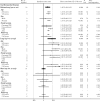Daytime Napping and the Risk of Cardiovascular Disease and All-Cause Mortality: A Prospective Study and Dose-Response Meta-Analysis
- PMID: 26158892
- PMCID: PMC4667384
- DOI: 10.5665/sleep.5246
Daytime Napping and the Risk of Cardiovascular Disease and All-Cause Mortality: A Prospective Study and Dose-Response Meta-Analysis
Abstract
Study objectives: To summarize evidence about the association between daytime napping and the risk of cardiovascular disease and all-cause mortality, and to quantify the potential dose-response relation.
Design: Meta-analysis of prospective cohort studies.
Methods and results: Electronic databases were searched for articles published up to December 2014 using the terms nap, cardiovascular disease, and all-cause mortality. We selected well-adjusted prospective cohort studies reporting risk estimates for cardiovascular disease and all-cause mortality related to napping. Eleven prospective cohort studies were identified with 151,588 participants (1,625,012 person-years) and a mean follow-up period of 11 years (60% women, 5,276 cardiovascular events, and 18,966 all-cause deaths). Pooled analysis showed that a long daytime nap (≥ 60 min/day) was associated with a higher risk of cardiovascular disease (rate ratio [RR]: 1.82 [1.22-2.71], P = 0.003, I(2) = 37%) compared with not napping. All-cause mortality was associated with napping for ≥ 60 min/day (RR: 1.27 [1.11-1.45], P < 0.001, I(2) = 0%) compared with not napping. In contrast, napping for < 60 min/day was not associated with cardiovascular disease (P = 0.98) or all-cause mortality (P = 0.08). Meta-analysis demonstrated a significant J-curve dose-response relation between nap time and cardiovascular disease (P for nonlinearity = 0.01). The RR initially decreased from 0 to 30 min/day. Then it increased slightly until about 45 min/day, followed by a sharp increase at longer nap times. There was also a positive linear relation between nap time and all-cause mortality (P for non-linearity = 0.97).
Conclusions: Nap time and cardiovascular disease may be associated via a J-curve relation. Further studies are needed to confirm the efficacy of a short nap.
Keywords: all-cause mortality; cardiovascular disease; meta-analysis; napping; siesta.
© 2015 Associated Professional Sleep Societies, LLC.
Figures





Comment in
-
Waking Up to the Importance of Sleep and Circadian Rhythms for Metabolic Health: The Need for In-Depth Phenotyping.Sleep. 2015 Dec 1;38(12):1847-8. doi: 10.5665/sleep.5224. Sleep. 2015. PMID: 26564132 Free PMC article. No abstract available.
References
-
- Cappuccio FP, Cooper D, D'Elia L, Strazzullo P, Miller MA. Sleep duration predicts cardiovascular outcomes: a systematic review and meta-analysis of prospective studies. Eur Heart J. 2011;32:1484–92. - PubMed
-
- Trichopoulos D, Tzonou A, Christopoulos C, Havatzoglou S, Trichopoulou A. Does a siesta protect from coronary heart disease? Lancet. 1987;2:269–70. - PubMed
Publication types
MeSH terms
LinkOut - more resources
Full Text Sources
Other Literature Sources
Research Materials

